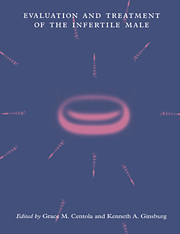Book contents
- Frontmatter
- Contents
- Preface
- List of contributors
- 1 Andrology
- 2 Sperm–egg interaction
- 3 Routine semen analysis
- 4 Computer-aided sperm analysis: a critical review
- 5 Antisperm antibodies: diagnosis and treatment
- 6 The sperm penetration assay
- 7 Intrauterine insemination for male factor
- 8 Processing human semen for insemination: comparison of methods
- 9 New assays for evaluating sperm function
- 10 Assisted reproductive technology for male factor infertility
- 11 Microinjection techniques for male infertility
- 12 Therapeutic donor insemination: screening, indications and technique
- 13 Endocrine assessment and hormone treatment of the infertile male
- 14 The urologic evaluation of the infertile male
- 15 Azoospermia: the diagnosis and treatment
- 16 White blood cells in semen and their impact on fertility
- 17 Psychological aspects of male infertility: lifting the shroud of shame
- 18 Evaluation of the female partner
- Index
15 - Azoospermia: the diagnosis and treatment
Published online by Cambridge University Press: 16 September 2009
- Frontmatter
- Contents
- Preface
- List of contributors
- 1 Andrology
- 2 Sperm–egg interaction
- 3 Routine semen analysis
- 4 Computer-aided sperm analysis: a critical review
- 5 Antisperm antibodies: diagnosis and treatment
- 6 The sperm penetration assay
- 7 Intrauterine insemination for male factor
- 8 Processing human semen for insemination: comparison of methods
- 9 New assays for evaluating sperm function
- 10 Assisted reproductive technology for male factor infertility
- 11 Microinjection techniques for male infertility
- 12 Therapeutic donor insemination: screening, indications and technique
- 13 Endocrine assessment and hormone treatment of the infertile male
- 14 The urologic evaluation of the infertile male
- 15 Azoospermia: the diagnosis and treatment
- 16 White blood cells in semen and their impact on fertility
- 17 Psychological aspects of male infertility: lifting the shroud of shame
- 18 Evaluation of the female partner
- Index
Summary
Introduction
Although obstruction of the reproductive tract leading to azoospermia is not the major cause of infertility, accurate diagnosis of its cause and its anatomic location is essential and may permit successful reconstruction. The diagnostic, laboratory, and surgical procedures utilized to arrive at the appropriate diagnosis and the available therapeutic modalities will be discussed.
Approach to the azoospermic male
A thorough reproductive, developmental, medical, surgical, and exposure history is essential for the accurate assessment of the azoospermic male. Male reproduction is dependent upon the normalcy of the hypothalamic–pituitary–gonadal axis, the testicle, the anatomic reproductive tract, and sexual function.
Azoospermia is defined as the absence of sperm from the ejaculate. There must be a normal conduit system and normal sexual function to allow for delivery of the sperm. The azoospermic individual has, by definition, an abnormality within one of these loci, and the appropriate evaluation should identify the site of the abnormality. The couple's reproductive, sexual, developmental, medical, and surgical histories should be elicited in an attempt to identify abnormalities within each of these processes necessary for normal reproductive function. A sexual and reproductive history may define the problem and its duration.
The developmental history attempts to define the normalcy of pubertal development, which is dependent on a normally functioning hypothalamic–pituitary–gonadal axis. The medical and surgical histories should identify potential risk factors which may contribute to an individual's infertility.
- Type
- Chapter
- Information
- Evaluation and Treatment of the Infertile Male , pp. 235 - 262Publisher: Cambridge University PressPrint publication year: 1996



